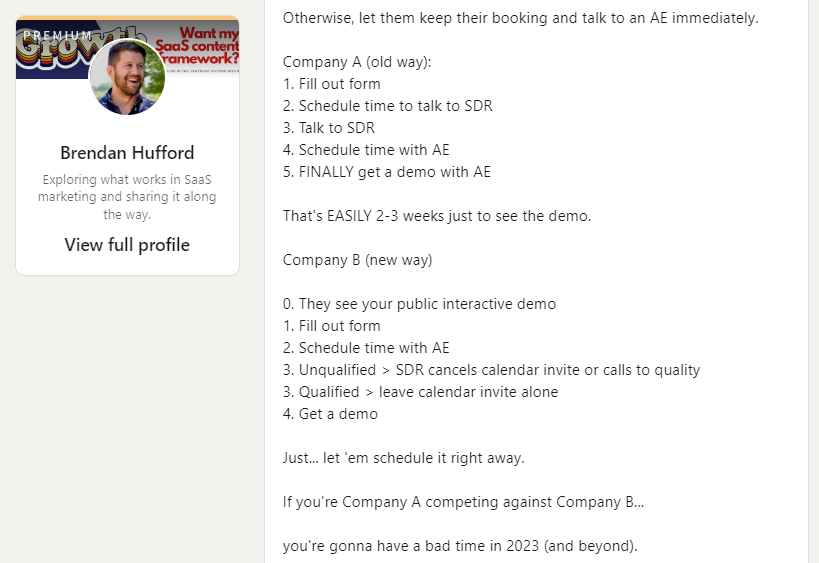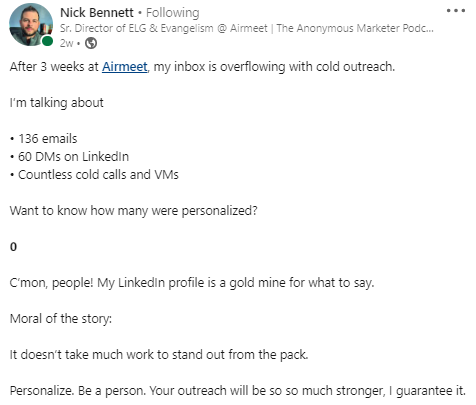Buyer Experience Tips That Take Less Than a Day to Implement

Today’s marketers are feeling the pinch.
With tighter budgets and fewer resources, they're at a point where they need to be doing everything they can to align with their potential customers.
But that doesn’t mean they have to redesign their entire strategy. Read on for seven quick, high-ROI tips to improve the buyer experience.
Tip #1: Use a calendar scheduler
One of the simplest ways to get in touch with your prospects faster is to let them book time with your sales team immediately.
SaaS marketing strategist, Brendan Hufford, suggests that this new way of booking demos can dramatically speed up the sales cycle in this LinkedIn post:
“If you're going to push for a demo booking, let them book the demo immediately.
Just embed a calendar.
Marketers act like we can't cancel a meeting.
Like it's some sort of impossible task.
Once somebody books a time, have your SDRs go through those bookings and call them to pre-qualify if they're in a gray area.
Otherwise, let them keep their booking and talk to an AE immediately.”

Brendan also recommends publicly sharing your public interactive demo first.
Doing so allows buyers to get familiar with your product and have a more productive, engaged conversation with sales.
Jason Oakley, Senior Director of Product Marketing at Klue, also advises marketers to automate qualification and scheduling. He explains:
“Demo requests should get booked instantly using something like Chili Piper or Calendly. Buyers shouldn’t have to wait days to book a demo.”
Anna Furmanov, Founder of Furmanov Marketing Consulting, agrees:
“Make it easy to schedule a call from your website by using Calendly OR have a Contact Us page. These should be two options for the visitor to your website. You don't need to email sales to schedule a call.”
Tip #2: Reduce the number of questions and people
Leads often switch hands in SaaS companies, and buyers get tired of answering the same questions every time they meet a new person.
As Kyle Lacy, CMO at Jellyfish, says, “The fewer human beings in the process, the better. Do not hand me off to three different people to help make a buying decision.”
Natalie Marcotullio, Head of Growth and Operations at Navattic, gives marketers several ideas to avoid this situation:

First, try using data from Clearbit or Keyplay to get accurate third-party data on prospects before they sign up for a call.
But you should also go straight to the source — on your form, ask questions like “Why did you sign up for this demo?” or “Please share anything that will help prepare for our meeting.”
The answers reduces the number of questions sales folks need to ask and enable SEs to tailor their demos accordingly.
Both of these exercises can help you understand your ICP at a deeper level, allowing you to incorporate more of the information they want and need to make a buying decision upfront.
Tip #3: Ask prospects what they want
The best way to know what prospects want is to ask them.
CEO & Keynote Speaker at LLJR Enterprise, Larry Long, urges marketers to speak with current clients to get a sense of why they bought your product and what might be lacking in your buyer experience.
“Talk to past buyers as well as Closed/Lost deals. Ask them to share their honest experience with your buyer journey. Capturing qualitative data straight from the mouths of those who have experienced it…is PRICELESS!”
Natalie shares how we try to ask the prospect what they are trying to solve at the beginning before jumping into the demo , adding, “The best AEs I’ve worked with will bring this information back up later in the sales process to remind people what they were looking for and how the product addresses that problem.”
Anna also advocates making the discovery call about the prospect:
“A lot of sales decks focus mostly on the product, product features, use cases, etc. Make it more about them and less about you.”
Tip #4: Audit your sign up or book a demo process
Have you gone through your own buyer flow lately?
Chances are the last time you did this was months ago, and the experience probably needs a refresh.
Andrew Capland, Founder of Delivering Value, encourages marketers to become a customer themselves.
“Here's a fun exercise: become a customer. Open an incognito browser. Sign up for your product.
Go through the onboarding flow. Then, pull out a real credit card and buy a paid plan. Take notes along the way. I promise you'll be shocked at the stuff you see.”
Anna also supports the audit route but takes it one step further, “Audit your whole website because this is one of the most important parts of the experience. Ask:
- Is your homepage header banner clear and simple, stating who you're for and what is your offering?
- Does the header banner image help build that understanding for the viewer, or does it make things more confusing?
- Does your homepage focus more on your product and your company vs. the target buyer's challenges and the value they'll get from using your product?
- Benefits to the buyer need to be higher up than features of your product. Do you have an easy way for the buyer to "test drive" your product?”
For sales led companies - Mark Huber, Head of Brand & Product Marketing at Metadata, recommends auditing your book a demo process from both the buyer's perspective and the company's perspective:
“From the buyer's perspective - review the automated email(s) they receive after booking a demo, when/how they can schedule time for the demo, and who they're scheduling time with (ex: SDR vs. AE).
From the company's perspective - review the internal notification email(s), the qualification and conversion info in these emails, and when and how new qualified leads are being handed off/routed.”
He and his team have used this method to great success:
“We audited our book a demo process last month at Metadata (led by our Senior Demand Generation Manager, Bryttney Blanken). Bryttney created and implemented the existing process we had. After doing the audit, she found things:
- She did not know were happening (and were breaking)
- The were over complicated and could be simplified for the buyer.”
Tip #5: Be part of slack or LinkedIn conversations with your ICP
Another way to improve your buyer journey is to engage with potential customers on LinkedIn, Slack, or other channels they participate in.
Olga Andrienko, VP of Brand Marketing at SEMRush, advises marketers to note trends or insights they can use to strengthen their brand story and participate in the conversations customers are already having about your product:
“Start tracking all of your mentions across social media and forums. Start replying to every mention and tap into the discussions that are already happening about your brand.”
Natalie puts her own spin on this advice, recommending marketers look for common questions customers or prospects ask about your product or your competitors and create enablement materials that answer those burning questions.
She adds, “Review websites like G2 and TrustRadius to make sure any missing buyer enablement is right where your buyers are actively shopping.”
Tip #6: Personalize your offers
Marketers are constantly publishing new email sequences, and BDRs are leveraging that messaging to death — DMing prospects on LinkedIn, cold-calling them, and even leaving voicemails.
Yet a majority of the time, this outreach is highly impersonal.
Nick Bennett, Chief Customer Officer & Co-Founder at TACK pointed out a disturbing pattern when he previously transitioned to a Senior Director of Evangelism role.
Out of the hundreds of outreach messages he received, none of them were personalized to his interests.

He added "Personalize your communication and offerings based on their past interactions and behaviors. This can be done by using data and insights gathered from their website activity, purchase history, and preferences."
Customers and prospects leave clues as to what they want. And as marketers, it’s your job to find them.
So take the time to personalize your communications and offerings. Look at people’s past interactions and behaviors.
Find ways to track website activity, review customers’ purchase history, collect customer and prospect preferences, and turn those insights into something personal.
Tip #7: Share your pricing
A big pet peeve of many B2B buyers is the barrier to pricing. They often have to schedule a call with sales to know whether a product is in their price range.
But Anna says, “Unless your product is beyond $100k, you should probably share your pricing. It's about helping your target buyer buy (in order to help your company sell).”
Erin Balsa, founder of Haus of Bold, couldn’t agree more — at a bare minimum, your website should have some sort of pricing indicator, like "pricing starts at $X per month."
She explains, “That way, people can get a general sense of whether or not to proceed. They don't waste time sitting on a discovery call and getting grilled only to discover your product is out of budget.
And it’s even more important in this day and age because prospects expect it. Erin continues, “Transparency is not just nice-to-have, it's expected. The more you can deliver the type of buyer experience YOU would like, the easier your sales process will be.”
Enhancing the buyer experience doesn’t have to be a rip-and-replace exercise. Simple adjustments to your book a demo flow, your messaging, your engagement habits, and your offers can make a world of difference to your prospects and your bottom line.
Want some more pointers? Check out: